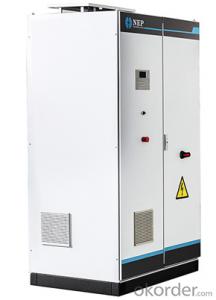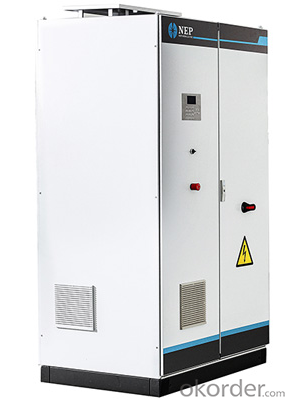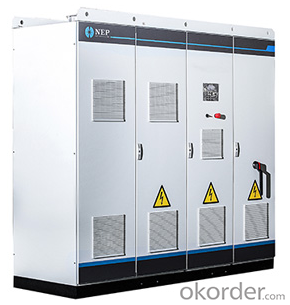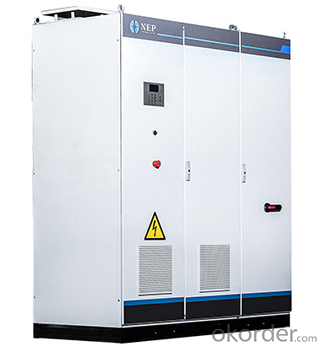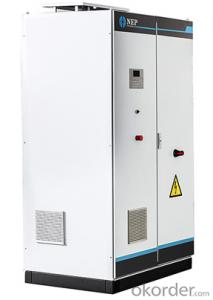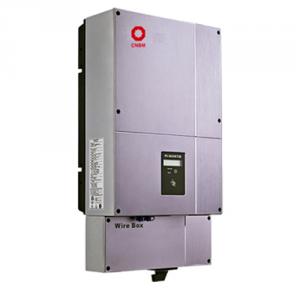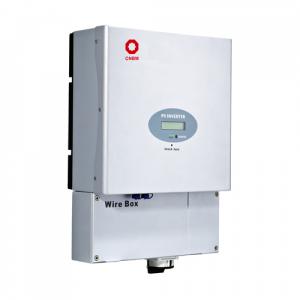Trace Solar Inverter Grid Tied BDE-630K
- Loading Port:
- Qingdao
- Payment Terms:
- TT OR LC
- Min Order Qty:
- 10 unit
- Supply Capability:
- 1000 unit/month
OKorder Service Pledge
OKorder Financial Service
You Might Also Like
Description:
Microinverter services respectly in every solar panel, a solar micro-inverter, converts direct current (DC) electricity from a single solar panel to alternating current (AC). The electric power from several micro-inverters is combined and fed into an existing electrical grid. Micro-inverters contrast with conventional string or central inverter devices, which are connected to multiple solar panels.
Characteristic & Advantages:
More Energy Harvest: Distributed MPPT allows10~25% more energy harvest
Simple: Modularized,single ac cable to the house
Reliability: Longer life time and almost 100% operation hours
Security: No high Voltage, makes safter environments
Inteligent : Monitoring each module and enlarge the efficency of the generation
Savings: No dc components and significantly save labor cost
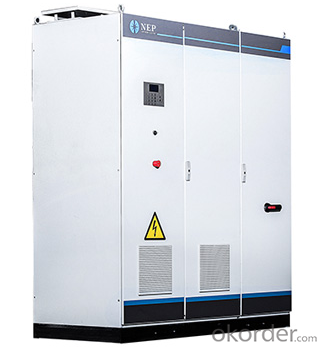
Datasheet:
★ Advanced digital control techniques using the latest DSP Optimized anti-islanding technique for the highest system reliability.
★Optimized Maximum Power Point Tracking technique guarantees the maximum power output from the PV array User oriented Graphic User Interface (GUI) on an integrated.
★ 128*64 graphic VFD and a keypad panel..
★Support multiple communication protocols, including RS232/RS485/Ethernet/Zigbee etc.
★ Complete protection functions to protect against reverse DC polarity,over temperature,over current,short cirucuit,over/under voltage,anti-islanding,etc.
★ Can be used at a wide range of environment temperatures and high altitude.
★ Automatically power-on in the morning and enter a low power mode at night. No local operators required for daily operation
- Q: How does a solar inverter affect the overall system cost?
- A solar inverter can have a significant impact on the overall system cost. While it is a crucial component that converts DC power generated by solar panels into AC power for use in homes or businesses, it also adds to the total expenses of installing a solar system. The cost of a solar inverter depends on factors such as its capacity, efficiency, and features. Higher capacity or more advanced inverters tend to be more expensive. However, investing in a high-quality inverter can improve the overall efficiency and performance of the solar system, potentially offsetting the additional cost in the long run.
- Q: What is the role of a grid-tie inverter in a solar PV system?
- The role of a grid-tie inverter in a solar PV system is to convert the direct current (DC) electricity generated by the solar panels into alternating current (AC) electricity that can be used to power electrical devices in a home or business. In a solar PV system, the solar panels produce DC electricity when exposed to sunlight. However, most homes and businesses use AC electricity, which is the standard form of electricity provided by utility companies. This is where the grid-tie inverter comes in. The grid-tie inverter takes the DC electricity produced by the solar panels and converts it into AC electricity that is compatible with the electrical grid. It ensures that the electricity generated by the solar panels is synchronized with the utility power and can be seamlessly integrated into the existing electrical system. One of the key functions of a grid-tie inverter is to match the frequency, voltage, and phase of the AC electricity generated by the solar panels with that of the utility power. This synchronization is crucial to ensure a smooth flow of electricity between the solar system and the grid, and to prevent any disruptions or damage to the electrical system. Additionally, a grid-tie inverter also monitors the electrical grid for safety reasons. It constantly checks the grid for any voltage or frequency fluctuations and can automatically disconnect from the grid in the event of a power outage or grid failure. This feature is important to protect the safety of electrical workers who may be repairing the grid during an outage. Furthermore, a grid-tie inverter allows for net metering, which is a billing arrangement where excess electricity generated by the solar system can be fed back into the grid. This means that if the solar system produces more electricity than is being used, the excess energy can be sent back to the grid and the homeowner or business owner can receive credits for the excess energy produced. This can help offset energy costs and potentially result in monetary savings. Overall, the grid-tie inverter plays a vital role in a solar PV system by converting the DC electricity generated by the solar panels into AC electricity that can be used to power electrical devices, ensuring synchronization with the electrical grid, monitoring the grid for safety, and enabling net metering for potential financial benefits.
- Q: How does a solar inverter handle grid frequency deviations?
- A solar inverter handles grid frequency deviations by continuously monitoring the frequency of the grid and adjusting its output accordingly. If the grid frequency deviates from the set nominal frequency, the inverter uses its internal control algorithm to regulate the power output from the solar panels to match the grid frequency. This ensures that the inverter stays synchronized with the grid and helps maintain stability in the overall power system.
- Q: Can a solar inverter be used with dual MPPT inputs?
- Yes, a solar inverter can be used with dual MPPT inputs. Dual MPPT (Maximum Power Point Tracking) inputs allow the inverter to optimize the power output from two separate solar arrays or strings, maximizing energy production even if the panels have different orientations or shading conditions. This feature is particularly useful in situations where there are multiple arrays with varying characteristics.
- Q: Can a solar inverter be used in systems with different module tilts?
- Yes, a solar inverter can be used in systems with different module tilts. Solar inverters are designed to convert the DC power generated by solar panels into AC power for use in the electrical grid or in the building. The module tilt refers to the angle at which the solar panels are installed, which can vary depending on factors like geographical location and specific installation requirements. Solar inverters are typically designed to be adaptable and can accommodate a wide range of module tilts, allowing for flexibility and optimization of solar energy generation.
- Q: What is the difference between a grid-tied and off-grid solar inverter?
- A grid-tied solar inverter is designed to convert the DC (direct current) electricity generated by solar panels into AC (alternating current) electricity that can be used in a home or business. It is connected to the utility grid, allowing surplus electricity to be sold back to the grid. In contrast, an off-grid solar inverter is specifically designed to be used in standalone systems where there is no access to the utility grid. It converts the DC electricity generated by solar panels into AC electricity for immediate use or storage in batteries for later use.
- Q: How does a solar inverter handle voltage flicker?
- A solar inverter handles voltage flicker by constantly monitoring the grid voltage and adjusting its output to maintain a stable voltage. It uses advanced control algorithms to quickly respond to fluctuations and minimize the impact of voltage flicker on the connected devices.
- Q: What is the maximum efficiency rating of a solar inverter?
- The maximum efficiency rating of a solar inverter can vary depending on the specific model and technology used, but generally, the highest efficiency ratings can range from 95% to 99%.
- Q: Can a solar inverter be used with a solar-powered electric vehicle charging station?
- Yes, a solar inverter can be used with a solar-powered electric vehicle charging station. The solar inverter helps convert the direct current (DC) power produced by the solar panels into alternating current (AC) power that can be used to charge electric vehicles. This allows for efficient and sustainable charging of electric vehicles using solar energy.
- Q: How does a solar inverter handle voltage stability in the grid?
- A solar inverter handles voltage stability in the grid by continuously monitoring the voltage levels and adjusting its output accordingly. It ensures that the electricity generated from solar panels is synchronized with the grid voltage, maintaining a stable voltage level. Additionally, advanced solar inverters incorporate features like voltage regulation and reactive power control to further enhance voltage stability in the grid.
Send your message to us
Trace Solar Inverter Grid Tied BDE-630K
- Loading Port:
- Qingdao
- Payment Terms:
- TT OR LC
- Min Order Qty:
- 10 unit
- Supply Capability:
- 1000 unit/month
OKorder Service Pledge
OKorder Financial Service
Similar products
Hot products
Hot Searches
Related keywords
